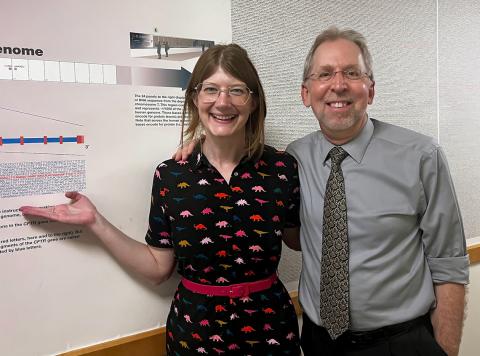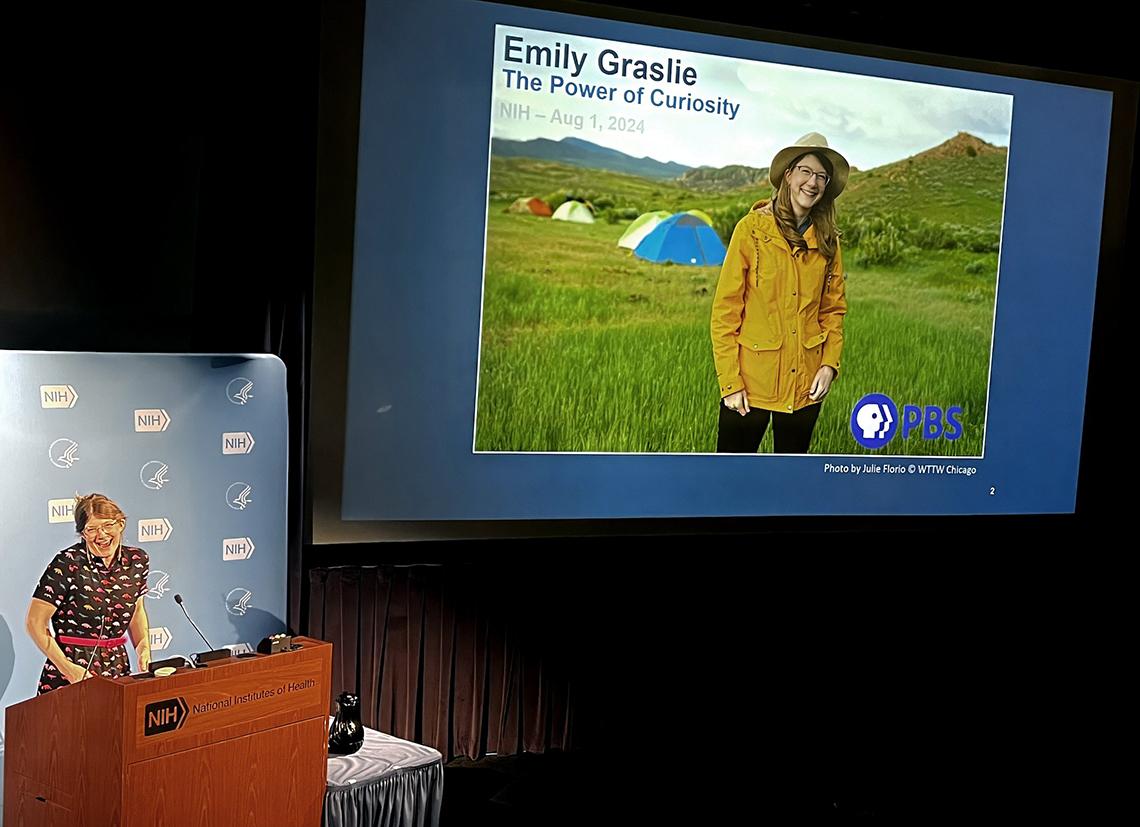Power of Curiosity
Graslie Shares Journey From Artist to Host of ‘Brain Scoop’

Photo: NHGRI
Emily Graslie would not be able to help scientists share what they do on “The Brain Scoop” without her background as a studio artist.
“I would not be able to do what I do had I not spent my formative years in art school, learning how to communicate a really complex idea in an instant,” said Graslie, creator and host of the popular natural history-themed YouTube series “Brain Scoop,” during a recent National Human Genome Research Institute lecture in Lipsett Amphitheater. Before her lecture, she visited the institute.
Graslie grew up in South Dakota, “a part of the country where many people don’t think about.” A descendent of farmers and ranchers, she saw firsthand the impact of climate change on the environment. One storm could wipe out a year’s worth of profit. Those experiences motivated her to study landscape painting in college.
During her senior year at the University of Montana, one of her friends showed her the natural history collection at the zoological museum on campus. Graslie’s friend invited her to help dissect a mouse. She filled out a label with information about the animal and who conducted the autopsy.
“The coolest thing about it was I got to sign my name on the label as the preparer,” she said. “I got this bolt of energy. I never felt so proud signing my name on a painting.”
From that moment, Graslie knew she wanted to stay involved in this work. She painted portraits of the museum’s specimens. To raise the museum’s profile, she curated an exhibit featuring art inspired by the museum’s collection. She posted photos of the show on her blog, which caught the attention of Hank Green, YouTuber and science communicator. He visited the museum to film an episode for his channel.

Photo: NHGRI
Weeks later, they launched the “Brain Scoop.” In each episode, Graslie shares with the public the behind-the-scenes work of natural history museums, their research and collections. Then, a few months later, the Field Museum in Chicago offered her the opportunity to become the museum’s chief curiosity correspondent.
She went from working in a museum that had 24,000 specimens to one that had more than 30 million objects and artifacts.
“I was out of my element,” she said. “But I knew as a non-scientist, I can be a fantastic proxy for the audience.”
Graslie has hosted and produced more than 200 videos about the research taking place at natural history museums around the country. Some of her most-watched videos are about the shape of King Tut’s head, bullet ant venom and the lack of representation for women science content creators.
When making content, Graslie meets people where they are. Scientific communicators must be aware of the principle of “psychological reactance,” also known as the boomerang effect, she said.
They cannot persuade communities who are resistant to a point of view with fact after fact. Finding out why someone doesn’t want to change their mind is more important, so “you change your strategy to better your own technique for taking anything like that to any kind of audience.”
An executive from Chicago’s PBS station saw her videos and asked if she wanted to host an hour-long TV show. Graslie thought it would be cool to travel through South Dakota and interview scientists.

Photo: NHGRI
She suggested South Dakota because there’s a rich fossil history. The rocks at Mt. Rushmore are some of the oldest rocks in the country. One of the largest and mostcomplete Tyrannosaurus rex skeletons ever found was discovered in the state, and Badlands National Park has fossil beds between 40 and 56 million years old. “The executive said, ‘That sounds awesome; let’s pitch it to PBS national!’” she recalled. So they did.
The executives told her that if the show was going to air nationally, they couldn’t film in just South Dakota. With that, the show became a three-part series exploring the paleontology and natural history of the Dakotas, Montana and Wyoming.
“That’s how we came up with Prehistoric Road Trip,” she said.
During filming, Graslie and her production team drove 6,000 miles and filmed at 34 locations across four states. It is the most diverse paleo program ever.
“That’s not just from the representation of people on screen but also in the representation of different organizations,” she said. “I wanted to go to the places where I felt I could relate most with people.”
Filming locations included community colleges and tribal museums. In one episode, she visited Wyoming’s Casper Community College, where she interviewed scientists who work in the same fossil beds where the first paleontologists in the country worked.
The final episode of the series explored the history of fossil theft on tribal land, a topic that was never covered before on a television program. Historically, paleontologists did not request permission to dig for fossils on tribal reservations. They took what fossils they excavated from those places.
“I care about bringing my platform as a non-scientist to highlight the stories of people that don’t have that kind of audience or the skills to get it out into the world,” she concluded. “I’m a conduit for the audience. I’m coming into these stories and using my camera to share them with the world.”
The full lecture can be viewed on demand at https://www.youtube.com/watch?v=Vc5wyV2Lp30.
The Brain Scoop can be viewed at https://www.youtube.com/user/thebrainscoop. Prehistoric Road Trip can be viewed at bit.ly/3ZQ01Mq.
